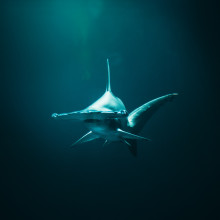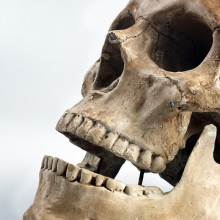The science that defined 2024
In this edition of The Naked Scientists, we ask leading experts in the fields of health, AI, space, marine biology, and archaeology about the moments that defined 2024…
In this episode

00:52 - Why is the UK's end of life bill so significant?
Why is the UK's end of life bill so significant?
Linda Bauld, University of Edinburgh
With 2024 coming to a close, the House of Commons voted on a landmark bill - which would allow some terminally ill adults to end their own lives. It was one of the most significant and sensitive topics to have been voted on by British MPs in recent decades. But what will it mean? And what still needs to happen for the bill to pass into law? I’ve been speaking with Linda Bauld who is a professor of public health at the University of Edinburgh…
Linda - This is an important bill. It's the terminally ill adult's end of life bill. And what it would do is make it legal for over eighteens who are terminally ill to be given assistance to end their own life. The reason it's important is because many countries around the world have looked at their aging populations, of course, and recognise that people who are nearer the end of life really should have more opportunities to think about how they die. Particularly people who are terminally ill and are experiencing a lot of suffering. So the bill just generally will be obviously for adults. They have to live in England and Wales, so it's the England and Wales bill. They have to have the mental capacity to make the choice, and to have that to be a settled and informed wish. And they actually have to make two separate declarations that are signed and witnessed. And then independent doctors have to be satisfied that the person is eligible. And the bit that's tricky and really hasn't been worked through and is different from other countries is a high court judge will be involved. They have to hear from at least one of the doctors. And they can also speak to the dying person or anyone else they consider appropriate. So it's really a physician assisted suicide and it could be a very important piece of legislation if it's passed.
Chris - What has actually happened in parliamentary terms though? Because there was a big vote and it passed through, but what does that actually mean in practical terms? They've had this first reading of it. Does anything actually change at this stage?
Linda - No, it doesn't change at this stage. What happens now is it goes through the parliamentary process. I think what's interesting about this is MPs are given a free vote. So normally for a new piece of legislation, at first reading, MPS would vote with their party and they'd be whipped to do so, which I always think is a tricky term, but that's the ancient term that we use. So free vote. And then what happens is it will go to committees. So there's a series of committee stages and there'll be further readings of the bill in the House of Commons, but also in the House of Lords. So we can't assume that this bill will become an act. It may not pass because what happens is through those stages, amendments can be introduced or people might change their mind.
Chris - In other countries where they do have equivalent legislation, I'm thinking Canada as one example, how has it gone down and been received and how does that compare with what is being proposed for the UK or rather England and Wales at this stage?
Linda - One piece of evidence I read suggests that over 200 million people have access to similar legislation. The first country to do this was Switzerland in 1942. Canada's important example, and so are many of the US states.They are different though, just in terms of how they operate their systems. So there's assisted dying and that means that the person who's terminally ill receives the drugs from a doctor and then they administer it themselves. So the person administers it. Assisted suicide is where you help somebody end their life. And euthanasia is the act of deliberately ending a person's life to relieve suffering. But assisted dying is what we're looking at here. So other countries have this as well. Oregon actually is probably the most useful example, Chris, because it's part of the US, the first part of the US to do this, I think from around 1997. And it's kept their legislation really quite similar throughout that period. And what they do in Oregon is actually quite similar to what's going to be in place in the UK. In relation to other countries, there are differences. So the groups that can be included, I think Netherlands and Belgium have some of the most expansive legislation. So children even are included in that under very specific circumstances. Some countries include people who are not going to die in the next six months, but are experiencing invariable suffering. So there's different versions of it, but I think what we're seeing internationally is a movement to consider a dignity in death really, which is what this is all about.
Chris - Would you regard 2024 then as a watershed moment for this?
Linda - It is a watershed moment because it's the first time that the UK parliament has voted in favour of it. I mean, in my area of research and public health, which often involves legislation on a range of issues, when you see a bill pass the first reading, even if it doesn't get through in that period it means it probably will come back in future years. So I think it's a watershed moment and in Scotland where I'm based, we would have separate legislation, but we've also seen a similar pattern of two bites of the cherry, so two previous rounds of legislation not passed. But the one that's coming before the Scottish Parliament now and will be coming forward next year. We'll see whether our MSPs vote in favor as has occurred in England.

06:10 - How did AI advance in 2024?
How did AI advance in 2024?
Mike Wooldridge, University of Oxford
It’s been another bumper year for artificial intelligence, with AI pioneers scooping Nobel Prize awards across different disciplines. In fact, it’s only been two years since the first public iteration of ChatGPT was launched, prompting excitement in some quarters and existential dread in others. So, how have these predictions turned out, and who are now the major players when it comes to AI? I’ve been speaking with the University of Oxford’s Mike Wooldridge.
Mike - So I think the first thing we've seen is that the debate, I think, has calmed down a little bit. People have used these tools, they've experienced them, they've got to know a little bit about what they're good at and what they're not good at. And I think, the initial, 'oh my goodness, we're on the edge of the end of AI'. That kind of feeling has sort of died down a little bit. So that actually I think is a huge relief. We've still had AI o the front pages very, very regularly, but not quite in the same slightly hysterical tones. If I look back, what else do I see? Well, one remarkable thing throughout the year has been the rise of NVIDIA. So NVIDIA's core technology is graphics processing units, GPUs. Now GPUs were invented so that teenagers could have realistic renditions of explosions in whatever computer game they were playing. That's what they're for. They're for processing graphics. But around about 2012, it was realized that exactly that technology was ideal for training neural networks, neural networks being the core technology underneath all of modern AI. And by using GPUs you got in 10 times more bang for your buck than you did using conventional CPUs. The CPUs, the central processing units that you have on a regular computer. Now, when that happened in 2012, we saw the progress in AI start to accelerate very quickly because we were getting 10 times more computer power available for the same amount of money.
Chris - I hadn't realised it's one of the world's most valuable companies, valued in the trillions. And, as it's been said in a gold rush like this, you don't sell gold, you sell shovels. And they're selling shovels.
Mike - They are selling the shovels that absolutely everybody wants. They specialise in this technology. And the reason that they are, I think at the moment, the world's highest value company has got nothing to do with teenagers playing computer games and everything to do with the fact that they sell GPU AI super computers. And if you want to build your GPT class model, you are going to need tens of thousands of those AI supercomputers. So the current valuation for NVIDIA is larger than the GDP of the United Kingdom. That's an extraordinary thought. They're larger than Amazon, larger than Google, larger than Apple. That's absolutely mind blowing.
Chris - NVIDIA are definitely the winners here because they are selling those shovels in this gold rush. But everyone else appears to be just peppering the world with AI, in what appears to be in a desperate hope that they'll hit the golden nugget of this is the killer function or the killer app or whatever. Is the bubble going to burst on this at some point? Because this is expensive, isn't it? The amount they must be investing in doing this, it must be bank balance breaking.
Mike - To be blunt, I don't think anybody really knows what's going to take off. But the hope is if you put this everywhere that you'll manage to land on the one that ends up winning. Another recent example is Apple intelligence, and this is Apple's foray into generative AI. And it's exactly this model that they're embedding large language model technology in particular across all of their products, into their email and sending text messages and their notes apps and all of that. In the hope that it takes off. There is no guarantee that it will take off. If we go back to the 1990s, I don't know if you remember Clippy, and I don't know if you remember how you felt about Clippy?
Chris - That annoying paperclip that kept popping up. 'It looks like you're trying to compose a letter. Let me help.' And it would screw up all the settings and you, it took half an hour to unpick all the damage it did. And then you wrote your letter and wished you'd never touched it. Yeah, yeah. I remember Clippy <laugh>.
Mike - So Clippy was Microsoft's 1990s attempt to embed AI in their product suite. And it didn't just fail, it attracted ridicule. It rapidly became an embarrassment and was very, very quickly dropped. But actually what we're seeing at the moment is not very different from Clippy. It's much more sophisticated technology, unimaginably more sophisticated technology. But the mode of using it as a kind of an assistant that helps you do things is very, very similar. So it may well be that people just don't pick up this technology. But yeah, what we're seeing is this just rush to put AI, generative AI everywhere in the hope that companies land on the killer app. And then how do they monetise it? How do they recoup these incredible returns on investment?

12:21 - How did space travel fare in 2024?
How did space travel fare in 2024?
David Whitehouse
2024 has been a stellar year in the field of astronomy. The James Webb Space Telescope has discovered atmosphere on planets over a hundred light years away, and the Euclid mission has begun to unravel some of the secrets of dark matter. But, down here on Earth, much of the buzz around space has been about humanity’s planned return to the Moon, even if we’re not sure who is set to get there first. I’ve been speaking to the space scientist and author David Whitehouse…
David - Well, I think it's got to be Elon Musk and the latest test, or one of the latest tests, of his Starship and his super heavy booster. It's more powerful than anything that has been launched before. It's taller. It's relatively simple in terms of what it does, but it's done some spectacular things. One of the latest, most watched space missions of recent years was when the star ship went into orbit and then flew around the world and came down in the Pacific, not far from Australia, but the super heavy booster that took it on the first few minutes of its flight and provided most of its thrust to get into orbit was actually returning to the launch pad and was captured by these two arms called chopsticks. And this was the very first attempt at doing that. And I don't think anybody expected it to work, but it was absolutely spectacular. And it shows the difference in momentum and achievement between SpaceX and NASA in the sense that SpaceX flies more frequently. It is learning faster, it's prepared to fail, but when it fails, it learns from that and progresses. And that's why Elon Musk has become the centerpiece of going back to the Moon. But also he has captured, with his Falcon Rockets, the majority of the market to take satellites into space and has the only working capsule that can take astronauts to and from the Space Station. So this year, next year and probably years to come, it's all about Elon Musk and what he does.
Chris - You mentioned NASA. Of course, we should have seen NASA astronauts back heading to the Moon this year, shouldn't we? That's been put back. Any update on that?
David - Well, yes, alongside Elon Musk's success, he has a role in the return to the Moon. And we should have seen, in December this year, astronauts on the Artemis 2 mission fly around the moon, testing out the Orion capsule and the space launch system. But that has been put back at least a year because of problems with the heat shield, with the Orion capsule. And it's somehow when put against Elon's success, showing that the Artemis plan to go to the Moon is now beginning to look complicated, very expensive, difficult to bring together and delayed. And so it seems to be going into the territory that sced all the previous attempts to put people back to the moon. And I think that one of Elon's goals, particularly since he's now so close to the incoming administration, will be to try and rationalise that and to try and well with his role in the Department of Government Efficiency to save money. But I think as part of saving a lot of money, he could actually bring SpaceX and NASA closer together. And we may see a big redesign of going back to the Moon.
Chris - It's quite a serious conflict of interest though, isn't it? Because you've got this person who is very successful in that respect commercially and in forays into space. At the same time, is going to command quite a lot of control and quite a lot of power and command, quite a lot of influence in Washington, in the administration, and therefore in what they decide to do. So is anyone kind of concerned about that or the fact that we have one person holding all the cards like this?
David - Yes. Elon Musk seems to have moved himself, through his political interest this year and his backing of President Trump, into a centre position for many things, including space. It was discussed on the grapevine that Elon Musk might even become the director of the administrator of NASA. But that presumably would've been too much of a conflict of interest. Having said that, it is traditional for the administrator of NASA to offer his resignation to a new administration in January for the president to decide who may want to replace him. So who knows.

17:21 - Which marine biology stories made waves in 2024?
Which marine biology stories made waves in 2024?
Liberty Denman, KAI
With the effects of climate change ramping up around the world and an increasing number of species being added to the endangered list, which marine biology have been making waves? Will Tingle has been speaking with marine science communicator, and host of the Out of Our Bubble podcast, Liberty Denman…
Liberty - Well, it's so hard to pick one thing in a space that moves so quickly and yet so slowly on a political front. So I'm actually not just going to pick one thing. I'm going to pick two, give you a bit of good news, and a bit of bad news. I say that the bad isn't even that bad news. It's just interesting. The IUCN have actually released an updated report on the global status of elasmobranchs, your sharks, ray, chimeras, which followed on from their last one in 2005. So it's been a nice 20 year waiting period of excitement to see what's changed. And then a bit of really good news is actually the Azores have declared the largest marine protected area in the North Atlantic. It will be Europe's most extensive MPA with their network covering 287,000 square kilometres, which has to be good news I think.
Will - In terms of the sharks IUCN thing, as you said, that seems an extraordinarily long time in order to get a report out. Why has it taken two and a half decades for us to get meaningful information?
Liberty - I think when you are covering off about 500 species of sharks, then you've got to consider all your rays as well. That's a lot of information to cover off a lot of species all around the world. It's a big task. So I feel that's always going to take a long period of time. And also when you're assessing change, when things politically take a long time to change. And also just to understand how populations are changing. Again, with long-lived species, these things take a long time to occur. So I think when you are mapping that out, it takes a really long time for these things to be assessed properly. So that's probably why it's taken 20 years or so. But it does have some good news, and some bad news.
Will - I tend to eat my veggies first. So what's the bad news?
Liberty - So unfortunately this group of species, the elasmobrachs, are of the most threatened vertebrates on the planet. So about a third of elasmobranchs are in a threatened or worse status on the IUCN red list of endangered species. Primarily due to overfishing, which is really evident in the reported demand for shark meat that has actually increased almost twofold. As well as also seeing a diversification in products that we're seeing. So there's also gill plates, liver oil skins on top of the sort of the standard meat and fins, if you will. And that can be quite an alarming thing I think to look at. Obviously it's a multifaceted issue. It's also not just overfishing. You've got you climate change, your pollution, all of these other elements to it. But the report does also outline some huge strides where we are making improvements, especially since 2005. So what we are seeing is a huge increase in information and also a diversity of researchers that is coming from. So to see that starting to shift is really, really exciting. And also some of the big improvements. So that knowledge base is across places in Asia, Africa, central America, the Caribbean, where there are these really, really exciting populations in such a huge diverse range of species that we're seeing there. So to be able to see that increase in focus on collaboration, also collaboration with industry to overcome these issues, working with everything from small scale fishers up to that kind of large scale offshore work is really exciting to see. And those things are outlined in there. So it is not all bad, it is mixed reviews, I think.
Will - And the good news sounds like it continues with this MPA in the Azores.
Liberty - It absolutely does. Some of you may be aware of the 30 by 30 target that's trying to protect 30% of the ocean by 2030. The Azorian Sea actually covers about 55% of the Portuguese economic exclusive zone, and that makes up about 15% of the total EU waters. So the regional government moving to protect this is an incredible feat. And what I think we're really looking for now is that kind of total protection, really limiting extractive activities, whether that is mining, fishing, even the recreational side of things as well, anything that could impact the biodiversity there. So what will now be critical is the kind of how that is managed and ensuring community buy-in from all of the different communities that are around The Azores. But it sounds like something that has been incredibly successful so far with the network that already has been existing historically. And to see that shifting is really positive to actually see some targets being hit because I think it can be quite depressing sometimes to look at all of the things which we've spoken about but not necessarily delivered on. So to see them actually delivering on this is really, really exciting.

22:02 - How did archaeology break new ground in 2024?
How did archaeology break new ground in 2024?
Emma Pomeroy, University of Cambridge
What were some of the groundbreaking moments in the field of archaeology? To find out, Chris Smith took a trip down to Queens’ College Cambridge to meet anthropologist Emma Pomeroy…
Emma - Yeah, I mean I was really spoiled for choice really with picking some studies. But this one was quite an important one. Looking at cave art from Suluwesi and trying to redate it. I mean, cave art is notoriously difficult to date. And essentially you have to date the layers of calcium carbonate that form over the top of it. And they've done this with some beautiful panels from two different sites and dated them to over 50,000 years, which is really quite remarkable. I mean, we probably think of a lot of cave art as being European, but this is showing some of the oldest that we have is actually from Southeast Asia and we have representations of animals and kind of panels and scenes that perhaps suggest there's some kind of narrative behind the work.
Chris - What does that tell us then about what we think was happening to anatomically modern humans in terms of how we were evolving thought processes, society and so on? Because we can get a lot out of what people were doing and drawing presumably in terms of those deductions.
Emma - Yes. Especially with this kind of art where they are representing sort of figures and animals. There's a real suggestion of narrative and storytelling. And this is something that we think is probably really important in human evolution and in the evolution of homo sapiens, our own species, and really recent human evolution as a way of sort of bonding groups together, but also passing on knowledge. And the fact that it comes from Southeast Asia is really exciting as well because a lot of people sort of up until about 20 years ago, assumed these figurative arts panels were really something European and associated with what we call the European upper Paleolithic, which is sort of the kind of stone tools that the earliest modern humans were making. So very exciting to have this from so far away from what many have considered to be the heartland of this kind of art.
Chris - What does this do to our understanding of our 'out of Africa' origins? Because certainly when I first started learning about paleoanthropology and so on, people were very fixed on the idea that about 50,000 years ago, that's when we began to leave Africa and go around the world. Well, if we've got this kind of level of detailed art already established so far from Africa, that must put the kibosh on that story a bit then.
Emma - So we still have dates for around, say, 50,000 years for dispersals of modern humans into Europe. But actually the dates that come from Southeast Asia, parts of China very famously Australia as well tend to be in this earlier period of 60,000 or even earlier.
Chris - The other thing that you've picked on is another paper, which fascinated me as the sort of doctor and infectious diseases person that I am. You've got this paper on tooth enamel and using that to work out what a person's immune system was doing and therefore what sorts of things they might have been succumbing to or diseases they may have been fighting off.
Emma - Yes, this was a really fascinating paper. Coming from a team led by Tammy Buenasera and colleagues from the University of California at Davis. And they focused on the remains of indigenous people from a site in California dating to the late 18th century. Basically, they looked at the tooth enamel and sometimes we do this quite often today to try and tell the sex of the people, but they also looked for signs of immune proteins such as immunoglobulin G and something called C-reactive protein. And these are signs of inflammation. So a stress response is happening in the body.
Chris - Why would those things be in the tooth enamel?
Emma - Because they're in the serum, so circulating in the blood, and then while the tooth is forming, they are also captured in the enamel. And what's really interesting about tooth enamel, unlike the rest of the skeleton, which sort of gets replaced periodically over the years, tooth enamel doesn't. So it kind of captures a snapshot about the individual at the time they're forming those teeth, so during their childhood.
Chris - This presumably gives us an insight into the kinds of things those people might have been succumbing to or the disease burden really at that point in their life.
Emma - Absolutely. So they don't have quite the same simple pattern as tree rings do, but you're right, they're kind of incremental structures, so structures that are forming bit by bit. And so these results are showing us something about the lived experience of those people. And quite surprisingly. So interestingly, they were able to show by comparing the remains of indigenous people in the 18th century with those of European descendants from the same kind of area and also a more recent kind of donated teeth, that those from the indigenous communities were suffering much higher levels of physiological stress. So they were finding more of these immunoglobulins and more c-reactive proteins, which was suggesting that they've perhaps got a higher disease burden or higher levels of other stresses. And this is really exciting because it's suggesting that we can have another window onto understanding how people's lives were and the kind of experiences they had.
Related Content
- Previous Titans of Science: Marc Abrahams
- Next Looking ahead to 2025










Comments
Add a comment